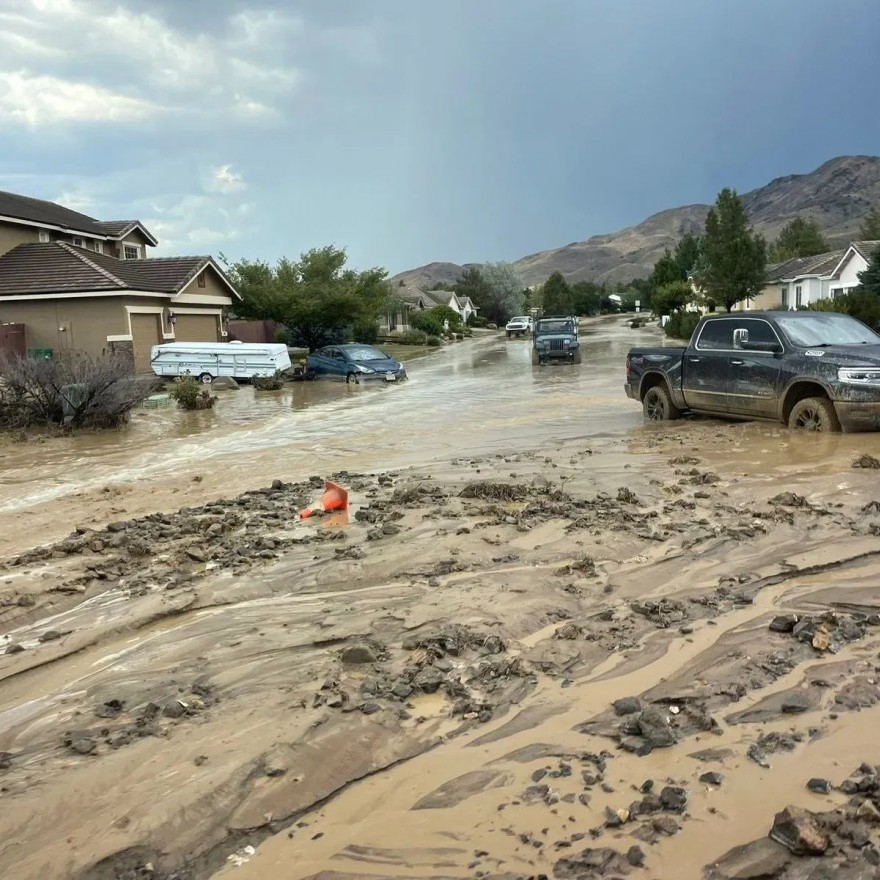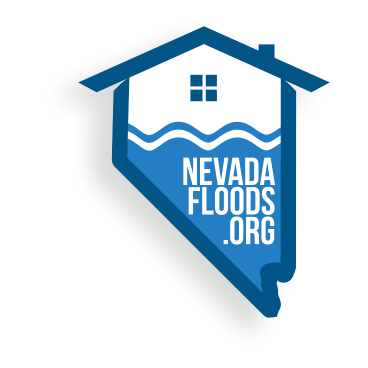
In March of 2025 the Division of Water Resources Floodplain Management Program published the After the Flood Guide; A Quick Guide for Nevada Communities and Residents in an effort to continue public education of post-flood matters. This guide details steps for the post-disaster process that encompasses the initial response to long-term recovery and mitigation. The following sections details a summary of the guide, to see the full guide visit the resources page at Nevadafloods.org here.
What’s in the Guide?
Snapshot
Nevada is not immune to floods. Riverine, alluvial and mudslides are three types of floods that have occurred in the history of our state. This section of the guide details some of the previous flood events in Nevada that includes the Great New Year’s flood of 1997.
Flood risk is increased in an area after wildfire. Fire events remove vegetation in the landscape and then precipitation is more likely to form as runoff as opposed to infiltrating into the ground. The Nevada Floodplain Management Program in cooperation with the University of Nevada developed the Nevada Flood After Fire Guide in 2022. This is detailed in this section along with a link to this resource here.
The National Flood Insurance Program (NFIP) is a federal program to help provide flood insurance to residents in participating communities with intent to reduce the financial impact of flooding on residents. Most standard homeowners’ insurance does not cover flood damage, so the intent is for NFIP to fill this gap. Participating communities are areas that agree to adopt and enforce local floodplain management regulations that aim to minimize future flood risks. A guide with more information is provided in Appendix A of the guide.
Agencies that are involved in Flood Risk and Flood Risk Management span local, state and federal agencies. Some of these agencies include the Nevada Division of Water Resources, FEMA and watershed scale regional authorities. They collaborate with each other and the public to produce flood risk maps, educate the public on flood risk and mitigation, and provide technical assistance to the participating communities in floodplain management.
Step-by-Step Recovery Process
The time after a flood event can be difficult on families, the financial and emotional toll from these events can have lasting effects. This guide includes seven steps to help families in the post-flood events by revealing some processes that are most important to get back to their lives, rebuilding and making homes flood resilient for the future.
Step 1: Immediate Response
Returning home after a flood event can be difficult for families emotionally because there is urgency to return and recover belongings. Prior and during a flood event, follow local evacuation procedures and only return when it is safe to do so. Using Nevada 511, you can get relevant information on roads when returning home. Document the flood damage and high-water marks at your home and collect records and receipts for damaged items as families return and prepare for assistance. Emergency notifications from local and state agencies, NOAA, FEMA, and Red Cross for resources.
Step 2: Clean Up & Safety
Clean up with caution. This section details hazards that can occur in the home upon return that can include, but not limited to electrical, gas leak, sediment build up, mold and bacteria, and hazardous materials that can be uncovered during clean up. Families are urged to use safe practices and personal protective equipment during home cleanup and debris removal.
Step 3: Assessing & Documenting Damage
During post flood activities, families can expect to receive visits from adjusters, government officials, contractors, and other associations. However, this environment has historically opened people up to scammers looking to take advantage of people in this vulnerable situation. A major part of this guide is to help people identify possible fraudsters post-flood.
Step 4: NFIP Flood Insurance
Do you have flood insurance? Do you know if your current homeowner’s insurance cover floods? Do you know how to get flood insurance? Do you know about flood insurance outside of a flood zone? This section provides many tools for these questions. The main tools in this section are https://floodsmart.gov/flood and https://floodsmart.gov/policy-quote for homeowners find and utilize resources on flood insurance.
Step 5: Post-Disaster Assistance
Did you know that a disaster declaration is required to receive assistance from FEMA or Small Business Administration? However, if you have flood insurance coverage you can file claims without a disaster declaration. Programs like FEMA Individual assistance and Temporary Housing, Mass Care and Emergency Assistance, Crisis Counseling Assistance and Training Program, and the Red Cross of Nevada are just a few of the other programs available to those affected by floods without insurance. Importantly, these programs will not replace flood insurance compensation. The average FEMA disaster grant was between $3,000 and $6,000 on average for the years between 2016 and 2022. During the same period, the average NFIP claim amount was $66,000.
Step 6: Rebuilding & Permits
Rebuilding after a flood event is a critical step for families to get back to normal but can be difficult to navigate. Permits are essential to safeguard communities to help ensure repairs adhere to the latest building codes and standards. It is also an opportunity for residents to rebuild with flood resiliency in mind to prevent further damage for future flood events. This section provides homeowners with a checklist during the permitting process. Homeowners can expect to document damage, contact local officials, consider higher standards for rebuilding, obtaining permit applications, submitting permits and final inspections for the Certificate of Occupancy.
Step 7: Making Your Home Flood Resilient
Protecting your home against natural hazards is a smart investment. Projects like elevating homes, improving drainage, and reinforcing structures can significantly reduce damage from floods and other hazards. Mitigation and prevention like this take upfront costs, but consider the benefits for the future. FEMA says that every $1 spent on natural hazard mitigation saves $6 in future disaster costs. This section includes general checklists for homeowners to consider how mitigation measures can be applied to their own homes to prevent future damage from natural hazards.
In summary, the After the Flood Guide; A Quick Guide for Nevada Communities and Residents details many resources for homeowners and families to use before and implement after flood events. This guide aims to reveal the in’s and out’s in steps to take after an event from the Immediate Response, Clean up and Safety, Document Damage, NFIP Flood Insurance, Disaster Assistance, Rebuilding and Permit’s, and Making Your Home Flood Resilient. With this guide and resources, homeowners can be prepared for what happens after a flood and help build a resilient community to natural disasters that will inevitably occur.
